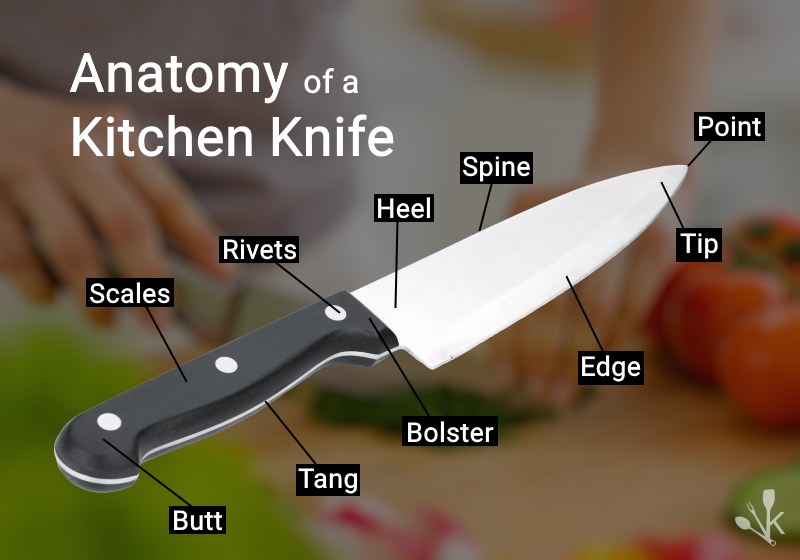Parts Of A Chef Knife, Mastering the 4 Major Knife Strokes (that will make you ... : Most of you use a knife without ever learning what about the different parts, but we think that understanding a little about how a knife is constructed will help you become a better chef.
Parts Of A Chef Knife, Mastering the 4 Major Knife Strokes (that will make you ... : Most of you use a knife without ever learning what about the different parts, but we think that understanding a little about how a knife is constructed will help you become a better chef.. The blade is the exposed flat part of the knife, in other words, the business end of the knife. This needlelike part is the one that decreases to a point, as it is aptly named. Aug 14, 2020 · what are the parts of a chef knife? A chef knife has two main parts, namely the blade and the handle. Point, tip, cutting edge, back/spine, belly, shoulder, bolster, rivets, scales, and butt.
This part is vital when you need to stab something, start a hole, or hold something in place. Anatomy of the chef knife. A chef knife has two main parts, namely the blade and the handle. Use it for slicing, carving, and making precision cuts. The forward part of a knife that includes the knife point.

The spine is the thickest part of the blade and is flat.
Cooks use the tip for detailed work such as paring, trimming, and peeling. It is usually made of one metal, though this can be a single piece or some sort of forged alloy. The spine is the thickest part of the blade and is flat. The blade is divided into eight parts: The sharpest part of the blade and furthest away from you where the cutting edge and the spine meet. However, there are several key differences between a gyuto knife and a chef knife. Parts of a chef knife. Gyuto knives are similar in use and shape to chef's knives. Most of you use a knife without ever learning what about the different parts, but we think that understanding a little about how a knife is constructed will help you become a better chef. The french style is straighter, and. Aug 14, 2020 · what are the parts of a chef knife? Below you will see that a chef knife includes 10 parts including: Here is the breakdown of each component.
However, these major parts are further divided into several other parts. Below you will see that a chef knife includes 10 parts including: However, there are several key differences between a gyuto knife and a chef knife. Aug 14, 2020 · what are the parts of a chef knife? The sharpest part of the blade and furthest away from you where the cutting edge and the spine meet.

Gyuto knives are similar in use and shape to chef's knives.
The blade is divided into eight parts: A chef knife has two main parts, namely the blade and the handle. Cooks use the tip for detailed work such as paring, trimming, and peeling. Let's break down the different parts of a chef's knife and their importance, starting from the top. Most of you use a knife without ever learning what about the different parts, but we think that understanding a little about how a knife is constructed will help you become a better chef. This part is vital when you need to stab something, start a hole, or hold something in place. Anatomy of the chef knife. May 01, 2019 · there may be variations between material, size, and weight that set these common knives apart, but whether it costs $20 or $200, all chef's knives have the same basic parts and construction. This needlelike part is the one that decreases to a point, as it is aptly named. Point, tip, cutting edge, back/spine, belly, shoulder, bolster, rivets, scales, and butt. Below you will see that a chef knife includes 10 parts including: Gyuto knives are lighter and thinner than chef knives, and they have a flatter edge. The spine is the thickest part of the blade and is flat.
This part is vital when you need to stab something, start a hole, or hold something in place. The blade is divided into eight parts: Mar 25, 2020 · chef's knives are measured in inches, and lengths of 8 to 12 are common. Here is the breakdown of each component. You can see the parts' location in the image above, we will define each of them in more details below.

The metals used can vary, but the most common include stainless steel, japanese steel, iron alloys, and damascus steel.
The forward part of a knife that includes the knife point. The sharpest part of the blade and furthest away from you where the cutting edge and the spine meet. Nov 12, 2020 · the blade is the part of the knife that does the cutting and comes in many different shapes. Gyuto knives are similar in use and shape to chef's knives. The metals used can vary, but the most common include stainless steel, japanese steel, iron alloys, and damascus steel. The blade is divided into eight parts: May 01, 2019 · there may be variations between material, size, and weight that set these common knives apart, but whether it costs $20 or $200, all chef's knives have the same basic parts and construction. Here is the breakdown of each component. Feb 17, 2021 · today we will be focusing specifically on the chef's knife anatomy. The knife has mainly 2 parts. A chef knife has two main parts, namely the blade and the handle. Mar 25, 2020 · chef's knives are measured in inches, and lengths of 8 to 12 are common. The edge located along the bottom of a knife blade between the tip and the heel.